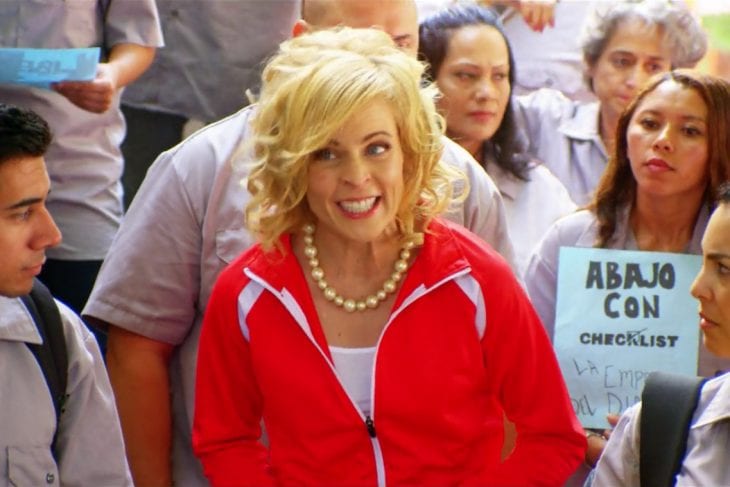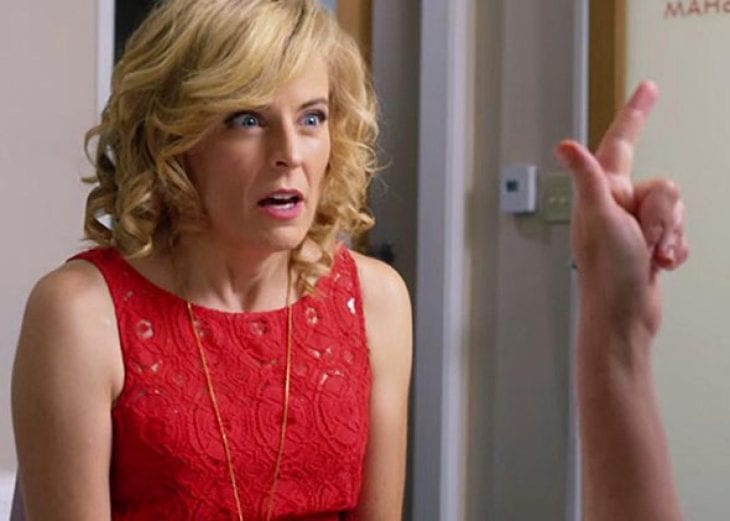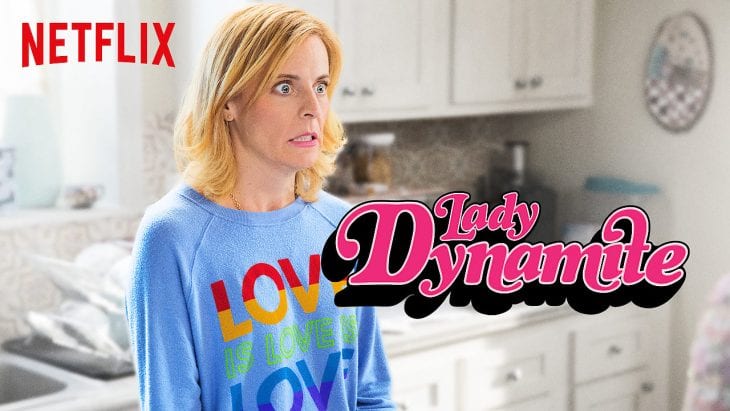Maria Bamford’s critically lauded Netflix show Lady Dynamite gets just about everything right—except for an unfortunate strain of biphobia. Created by Bamford, along with Pam Brady (South Park) and Mitchell Hurwitz (Arrested Development), the show is a fictionalized version of the alt comic’s life. Lady Dynamite is such a big-hearted, humanistic look at what it’s like to live with a mental illness (Bamford has bipolar II in real life) that the biphobic turn the show takes in its second episode, “Bisexual Because of Meth,” is both bizarre and jarring.
In the episode, Maria’s friend and assistant, Larissa (Lennon Parham), offers to set her up with Shane, a bisexual former meth addict. Maria initially balks at the offer. “It may be a little too complicated, too much for me right now,” she says. But after finally agreeing to go on the date, she discovers the two have a lot in common—neither want to be defined by their illnesses. The trouble is that she doesn’t understand what bisexuality actually is. Maria tells her agent, Bruce Ben-Bacharach (Fred Melamed), that her new beau is a “formerly meth-fueled bisexual” who is “now straight… and straight.” Of course, bisexuality is a recognized sexual orientation, not the product of addiction.
While the opinions of Lady Dynamite’s creators might differ from those of its characters, the show has a difficult time separating Maria’s ignorance from just plain ol’ ignorance. While she’s on her way to meet Shane, Maria’s talking radio (a la My Mother the Car) encourages her to hook up with him, despite her hesitations about getting physical. “Go get ‘em, tiger!” the radio advises. “And use a goddamn condom. He is bisexual.” The implication is that because he swings both ways, he must be promiscuous. The show does nothing to dispel that myth: When she arrives, Maria discovers the waiter from their date giving him a blowjob. To make matters worse, Shane also has a live-in boyfriend, Gabriel (Craig Frank).

Source: Vulture
The episode attempts to lampshade their behavior by showing that Shane doesn’t seem to understand how bisexuality works either. He believes that if you’re bi, that means it’s OK to cheat on your partner—as long as it’s not a man. “We have our relationship, and she’s my woman relationship,” Shane asserts with a smile. “I’m bi-sexual.” Gabriel responds, “That’s not what it means, and you know it!” Maria’s takeaway from the encounter, though, appears to miss the point entirely: It simply proves her initial prejudice right—that she shouldn’t be dating someone who is bisexual to begin with.
What’s bizarre about how Lady Dynamite handles its potential teachable moment is that in the very next episode, the show goes to great lengths to correct its characters’ behavior when it comes to race. Maria gets a part on a television sitcom called White Trash, which is about two black garbage people (played by the Lucas Brothers). After attending a support group called “L.A. PURE” (People United for Racial Equality), the other members inform her the program’s premise is racist. “We don’t call them ‘garbage people’ any more!” a group member gasps. Maria attempts to intervene by pointing out the show’s potentially problematic content to its producers—who proceed by giving all the Lucas Brothers’ lines to the white characters. Problem fixed?
While the opinions of Lady Dynamite’s creators might differ from those of its characters, the show has a difficult time separating Maria’s ignorance from just plain ol’ ignorance.
In meta fashion, Lady Dynamite brings in Oscar-winning screenwriter John Ridley (of 12 Years a Slave, no less) to explain what Maria did wrong. She claims she was just trying to “say something about race.” He explains that he knows he has good intentions. “Oh, I don’t think what you’re doing is malicious,” Ridley says. “It’s just recklessly ignorant.” The exchange is a really pointed, incisive takedown of white people who believe that they can “solve racism,” but Lady Dynamite doesn’t extend the same nuance or thoughtfulness to its take on male bisexuality. Instead of combating stigma, it appears as if the show is reinforcing harmful yet sadly pervasive myths about the bi community.

Source: slate.com
That’s disappointing not just because Lady Dynamite is otherwise so good but because television so frequently fails when it comes to handling bisexuality—especially when it comes to men. Although recent shows like Crazy Ex-Girlfriend, Revenge, and Halt and Catch Fire have introduced bisexual male characters that transcend stereotypes, they remain the exception that proves the rule. Bisexual men, when they’re allowed to be onscreen at all, are treated as promiscuous, immoral, or suspect—as if they are temporarily confused about their orientation and will pick a side later. These misinformed tropes aren’t just behind the times; for a community struggling for recognition, they’re also very dangerous.
A classic example of this tendency is Will and Grace, the ‘90s sitcom that was a groundbreaking moment for gay visibility on TV. How the show dealt with bisexuality, though, left much to be desired. In a late period episode of the program, Will (Eric McCormack) begins seeing a handsome baker, Edward (Stuart Townsend), who also has sex with Karen (Megan Mullally). Will wonders how this could be: “You’re gay!” Edward corrects him, “I like to think of myself as pansexual.” Will isn’t buying it. “Pansexual?” he scoffs. “Isn’t that just a rest stop on the highway to homo?” As if to further indicate that his sexuality is aberrant, Edward uses the opportunity to coerce them into the threesome, before ditching them to have sex with Karen’s maid.
That incident mirrors nearly identical moments on Sex and the City and Glee. Bisexuality isn’t presented as a steadfast orientation but a phase—or as Carrie puts it, a “layover on the way to Gaytown.” In the latter program, Blaine (Darren Criss), who otherwise identifies as gay, thinks that he might be interested in women. Kurt (Chris Colfer) doesn’t want to hear it. “Bisexual’s a term that gay guys in high school use when they wanna hold hands with girls and feel like a normal person for a change,” he retorts. The writers seem to side with Kurt: After having one date with Rachel (Lea Michele), Blaine decides that bisexuality isn’t for him. That would be fine (sometimes people try things and don’t like it) if fluidity were presented as a viable option.
In addition to being corrupt, TV has a difficult time letting its sexually fluid characters even say the word “bisexual.” After Claire (Robin Wright) and Frank Underwood (Kevin Spacey) engage in the threesome with Frank’s driver on House of Cards, the Netflix show’s creator, Beau Willimon, attempted to explain away the character’s sexuality as merely part of his unquenchable lust for power. “He’s a man with a large appetite, he’s a man who does not allow himself to be placed in any sort of milieu or with one definition,” Willimon said. This is despite the fact that it was previously established that the fictional POTUS had a relationship with another man in college.

Source: New On Netflix UK
Bisexuality isn’t presented as a steadfast orientation but a phase—or as Carrie puts it, a “layover on the way to Gaytown.”
If male bisexuals on television are stigmatized and erased, it only reaffirms the shame and widespread misinformation to which bisexual people—of all genders—are subjected in real life. In a 2015 Gallup survey of LGBT Americans, respondents reported that bi men faced some of the highest barriers to acceptance in the queer community. Twenty-five percent of those polled said that there was a “a lot of acceptance” for lesbian women, while 15 percent reported the same level of acceptance for gay men. Meanwhile, just eight percent agreed that bisexual males were accepted. A 2013 study from the University of Pittsburgh suggested why this might be, finding that 15 percent of people, even today, still agree with Carrie Bradshaw and Will Truman: Bisexuals don’t exist. Hell, even the New York Times still thinks the jury is out.
According to researchers from Pitt, bisexual erasure can “cause feelings of isolation and marginalization, which prior research has shown leads to higher substance use, depression, and risky sexual behavior.” A separate 2012 study from the U.K.’s Centre for Citizenship, Identities and Governance and Faculty of Health and Social Care found these factors further lead to an increased suicide rate among bisexual people: Bi men are 6.3 times more likely to try to end their life than heterosexuals. That rate was only slightly lower for bisexual women, who were 5.9 times more likely than straight folks to attempt suicide.
